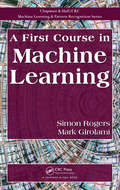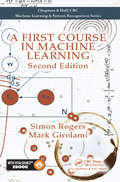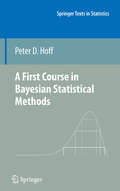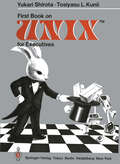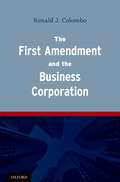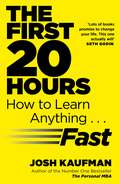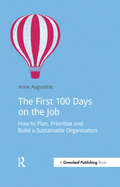- Table View
- List View
A First Course in Quality Engineering: Integrating Statistical and Management Methods of Quality, Third Edition
by K. S. Krishnamoorthi V. Ram Krishnamoorthi Arunkumar PennathurThe third edition of this textbook improves on the strengths of the earlier editions both in content and presentation. Of the important features of the textbook is the inclusion of examples from real-world to illustrate use of quality methods in problem solving. A thorough revision is made of the text to make all chapters suitable for self-study as well.
A First Course in Quality Engineering: Integrating Statistical and Management Methods of Quality, Third Edition
by K. S. Krishnamoorthi V. Ram Krishnamoorthi Arunkumar PennathurThis book is the leader among the new generation of text books on quality that follow the systems approach to creating quality in products and services; the earlier generations focused solely on parts of the system such as statistical methods, process control, and management philosophy. It follows the premise that the body of knowledge and tools documented by quality professionals and researchers, when employed in designing, creating and delivering the product will lead to product quality, customer satisfaction and reduced waste. The tools employed at the different stages of the product creation cycle are covered in this book using real world examples along with their theoretical bases, strengths and weaknesses. This textbook can be used for training - from shop floor personnel to college majors in business and engineering to practicing professionals. Graduate students training as researchers in the quality field will also find useful material. The book has been used as the text for a Professional Series Massive Open Online Course offered by the Technical University of Munich on edX.org, through which tens of thousands of participants from all over the world have received training in quality methods. According to Professor Dr. Holly Ott, who chose the book for the course, the text is one of the main factors contributing to success of this MOOC. The Third Edition has been fully revised to be friendly for self-study, reflects changes in the standards referenced such as ISO 9000, and includes new examples of application of statistical tools in health care industry. Features: Reviews the history of quality movement in the U.S. and abroad Discusses Quality Cost analysis and quality’s impact on a company’s bottom line Explains finding customer needs and designing the product using House of Quality Covers selection of product parameters using DOE and reliability principles Includes control charts to control processes to make the product right-the-first-time Describes use of capability indices Cp and Cpk to meet customer needs Presents problem solving methodology and tools for continuous improvement Offers ISO 9000, Baldrige and Six Sigma as templates for creating a quality system
A First Course in Optimization
by Charles ByrneGive Your Students the Proper Groundwork for Future Studies in OptimizationA First Course in Optimization is designed for a one-semester course in optimization taken by advanced undergraduate and beginning graduate students in the mathematical sciences and engineering. It teaches students the basics of continuous optimization and helps them better
A First Course in Machine Learning
by Mark GirolamiA First Course in Machine Learning covers the core mathematical and statistical techniques needed to understand some of the most popular machine learning algorithms. The algorithms presented span the main problem areas within machine learning: classification, clustering and projection. The text gives detailed descriptions and derivations for a smal
A First Course in Machine Learning
by Simon Rogers Mark Girolami"A First Course in Machine Learning by Simon Rogers and Mark Girolami is the best introductory book for ML currently available. It combines rigor and precision with accessibility, starts from a detailed explanation of the basic foundations of Bayesian analysis in the simplest of settings, and goes all the way to the frontiers of the subject such as infinite mixture models, GPs, and MCMC."—Devdatt Dubhashi, Professor, Department of Computer Science and Engineering, Chalmers University, Sweden "This textbook manages to be easier to read than other comparable books in the subject while retaining all the rigorous treatment needed. The new chapters put it at the forefront of the field by covering topics that have become mainstream in machine learning over the last decade."—Daniel Barbara, George Mason University, Fairfax, Virginia, USA "The new edition of A First Course in Machine Learning by Rogers and Girolami is an excellent introduction to the use of statistical methods in machine learning. The book introduces concepts such as mathematical modeling, inference, and prediction, providing ‘just in time’ the essential background on linear algebra, calculus, and probability theory that the reader needs to understand these concepts."—Daniel Ortiz-Arroyo, Associate Professor, Aalborg University Esbjerg, Denmark "I was impressed by how closely the material aligns with the needs of an introductory course on machine learning, which is its greatest strength…Overall, this is a pragmatic and helpful book, which is well-aligned to the needs of an introductory course and one that I will be looking at for my own students in coming months."—David Clifton, University of Oxford, UK "The first edition of this book was already an excellent introductory text on machine learning for an advanced undergraduate or taught masters level course, or indeed for anybody who wants to learn about an interesting and important field of computer science. The additional chapters of advanced material on Gaussian process, MCMC and mixture modeling provide an ideal basis for practical projects, without disturbing the very clear and readable exposition of the basics contained in the first part of the book." —Gavin Cawley, Senior Lecturer, School of Computing Sciences, University of East Anglia, UK "This book could be used for junior/senior undergraduate students or first-year graduate students, as well as individuals who want to explore the field of machine learning…The book introduces not only the concepts but the underlying ideas on algorithm implementation from a critical thinking perspective."—Guangzhi Qu, Oakland University, Rochester, Michigan, USA
A First Course in Machine Learning
by Simon Rogers Mark Girolami"A First Course in Machine Learning by Simon Rogers and Mark Girolami is the best introductory book for ML currently available. It combines rigor and precision with accessibility, starts from a detailed explanation of the basic foundations of Bayesian analysis in the simplest of settings, and goes all the way to the frontiers of the subject such as infinite mixture models, GPs, and MCMC."—Devdatt Dubhashi, Professor, Department of Computer Science and Engineering, Chalmers University, Sweden "This textbook manages to be easier to read than other comparable books in the subject while retaining all the rigorous treatment needed. The new chapters put it at the forefront of the field by covering topics that have become mainstream in machine learning over the last decade."—Daniel Barbara, George Mason University, Fairfax, Virginia, USA "The new edition of A First Course in Machine Learning by Rogers and Girolami is an excellent introduction to the use of statistical methods in machine learning. The book introduces concepts such as mathematical modeling, inference, and prediction, providing ‘just in time’ the essential background on linear algebra, calculus, and probability theory that the reader needs to understand these concepts."—Daniel Ortiz-Arroyo, Associate Professor, Aalborg University Esbjerg, Denmark "I was impressed by how closely the material aligns with the needs of an introductory course on machine learning, which is its greatest strength…Overall, this is a pragmatic and helpful book, which is well-aligned to the needs of an introductory course and one that I will be looking at for my own students in coming months."—David Clifton, University of Oxford, UK "The first edition of this book was already an excellent introductory text on machine learning for an advanced undergraduate or taught masters level course, or indeed for anybody who wants to learn about an interesting and important field of computer science. The additional chapters of advanced material on Gaussian process, MCMC and mixture modeling provide an ideal basis for practical projects, without disturbing the very clear and readable exposition of the basics contained in the first part of the book." —Gavin Cawley, Senior Lecturer, School of Computing Sciences, University of East Anglia, UK "This book could be used for junior/senior undergraduate students or first-year graduate students, as well as individuals who want to explore the field of machine learning…The book introduces not only the concepts but the underlying ideas on algorithm implementation from a critical thinking perspective."—Guangzhi Qu, Oakland University, Rochester, Michigan, USA
A First Course in Bayesian Statistical Methods (Springer Texts in Statistics)
by Peter D. HoffA self-contained introduction to probability, exchangeability and Bayes’ rule provides a theoretical understanding of the applied material. Numerous examples with R-code that can be run "as-is" allow the reader to perform the data analyses themselves. The development of Monte Carlo and Markov chain Monte Carlo methods in the context of data analysis examples provides motivation for these computational methods.
A First-class Catastrophe: The Road To Black Monday, The Worst Day In Wall Street History (PDF)
by Diana B. HenriquesThe definitive account of the crash of 1987, a cautionary tale of how the U. S. financial system nearly collapsed--from the bestselling author ofThe Wizard of Lies Monday, October 19, 1987, was by far the worst day in Wall Street history. The market fell 22. 6 percent - almost twice as bad as the worst day of 1929 - equal to a one-day loss of nearly 5,000 points today. Black Monday was more than seven years in the making and threatened nearly every U. S. financial institution. Drawing on superlative archival research and dozens of original interviews Diana B. Henriques weaves a tale of missed opportunities, market delusions, and destructive actions that stretched from the "silver crisis" of 1980 to turf battles in Washington, a poisonous rivalry between the New York Stock Exchange and the Chicago Mercantile Exchange, and the almost-fatal success of two California professors whose idea for reducing market risk spun terribly out of control. As the story hurtles forward, the players struggle to forestall a looming market meltdown and unexpected heroes step in to avert total disaster. For thirty years, investors, regulators, and bankers have failed to heed the lessons of 1987, even as the same patterns have resurfaced, most spectacularly in the financial crisis of 2008. A First-Class Catastrophe offers a new way of looking not only at the past, but at our financial future as well.
First Book on UNIXTM for Executives
by Yukari Shirota Tosiyasu L. KuniiA good introduction to a new product or concept is vital. This is particularly true for a versatile software system such as UNIX. UNIX provides the depth and intelligence to make your computer work hard for you. It will help you create software and help you use your office automation equipment to create and edit documents. For your intro duction to UNIX, you want a great little book. That is what this work is meant to be. This book is designed for non-computer specialists, especially for executives, ad ministrators and managers who want to make better use of their software specialists and experts. The way this Springer edition has come to be published is itself a story. Back about 1980, the founder and president of one of the more successful microcomputer companies, Mr. Kazue Ishii of CEC, wanted to start somethig that would be brilliant, sophisticated, innovative, and which would grow steadily. Out of many proposals, the one he accepted happened to be mine. The proposal was to build a family of network workstations for computer-aided design/manufacturing and office automation. UNIX was to be used as a software generator. But he had a hard time understanding UNIX, what good it is and how good it is ... Spending a significant amount of time with a popular computer columnist, Miss Yukari Shirota, I compiled this book for him. I found this book generally useful for top executives, managers, planners and office administrators whose background is outside software engineering. Dr.
First Be Nimble: A Story About How to Adapt, Innovate and Perform in a Volatile Business World
by Graham WinterThe how-to guide to building an adaptive, productive business environment Graham Winter, author of the best-selling Think One Team, brings you First Be Nimble: A Story about How to Adapt, Innovate and Perform in a Volatile Business World. This book addresses the challenge of how to equip businesses to adapt and thrive in an unpredictable and demanding economy. Told in the form of a fable and illustrated with case studies and powerful tools, the book is designed to engage, inspire, and inform readers from all walks of business life. Helping leaders, teams, and whole organisations to bring their values to the frontline of the battle to be adaptive and productive, First Be Nimble shows readers how to align people and teams, collaborate and co-create with others, reduce resistance to change, boost trust, personal resilience, and performance, and prepare for the unique challenges of adaptive change. Helps businesses adapt to today's environment, learn to innovate, and build a "one team'" mentality Gives leaders the practical tools to facilitate change and foster the conversations that help people to learn and grow together Uses a unique, fable-style format, with inspirational examples, to bring key concepts to life While many business leaders are well versed in the importance of company values, they are often ignorant of how to bring them to life, and how to build an adaptive, high performing business. First Be Nimble is here to help.
First Be Nimble: A Story About How to Adapt, Innovate and Perform in a Volatile Business World
by Graham WinterThe how-to guide to building an adaptive, productive business environment Graham Winter, author of the best-selling Think One Team, brings you First Be Nimble: A Story about How to Adapt, Innovate and Perform in a Volatile Business World. This book addresses the challenge of how to equip businesses to adapt and thrive in an unpredictable and demanding economy. Told in the form of a fable and illustrated with case studies and powerful tools, the book is designed to engage, inspire, and inform readers from all walks of business life. Helping leaders, teams, and whole organisations to bring their values to the frontline of the battle to be adaptive and productive, First Be Nimble shows readers how to align people and teams, collaborate and co-create with others, reduce resistance to change, boost trust, personal resilience, and performance, and prepare for the unique challenges of adaptive change. Helps businesses adapt to today's environment, learn to innovate, and build a "one team'" mentality Gives leaders the practical tools to facilitate change and foster the conversations that help people to learn and grow together Uses a unique, fable-style format, with inspirational examples, to bring key concepts to life While many business leaders are well versed in the importance of company values, they are often ignorant of how to bring them to life, and how to build an adaptive, high performing business. First Be Nimble is here to help.
The First Amendment and the Business Corporation
by Ronald J. ColomboThe role of the business corporation in modern society is a controversial one. Some fear and object to corporate power and influence over governments and culture. Others embrace the corporation as a counterweight to the State and as a vehicle to advance important private objectives. A flashpoint in this controversy has been the First Amendment to the U.S. Constitution, which enshrines the fundamental rights of freedom to speech, religion, and association. The extent to which a corporation can avail itself of these rights goes a long way in defining the corporation's role. Those who fear the corporation wish to see these rights restricted, while those who embrace it wish to see these rights recognized. The First Amendment and the Business Corporation explores the means by which the debate over the First Amendment rights of business corporations can be resolved. By recognizing that corporations possess constitutionally relevant differences, we discover a principled basis by which to afford some corporations the rights and protections of the First Amendment but not others. This is critically important, because a "one-size-fits-all" approach to corporate constitutional rights seriously threatens either democratic government or individual liberty. Recognizing rights where they should not be recognized unnecessarily augments the already considerable power and influence that corporations have in our society. However, denying rights where they are due undermines the liberty of human beings to create, patronize, work for, and invest in companies that share their most cherished values and beliefs.
The First 20 Hours: How to Learn Anything ... Fast
by Josh KaufmanJosh Kaufman, bestselling author of The Personal MBA, is back with his new book, The First Twenty Hours, to teach readers how to learn anything... fast!'Lots of books promise to change your life. This one actually will' -Seth GodinPick up any new skill in just 20 hours... Want to learn to paint, play the piano, launch a business, fly a plane? Then pick up this book and set aside twenty hours to go from knowing nothing to performing like a pro. That's it. Josh Kaufman, author of international bestseller The Personal MBA, has developed this brilliant approach to mastering anything fast. You'll learn how to: • Focus energy on acquiring key skill sets • Eliminate obstacles and discover critical tools • Create rapid feedback loops • Work against the clock to get better fast With examples ranging from writing a web program to learning an instrument to picking up windsurfing, Kaufman shows how to break complexity into simple tasks, make the very best of your limited time and solve unexpected problems. In The First 20 Hours you'll learn how to acquire any skill in record time - and have a lot of fun along the way. 'After reading this, you'll be ready to take on any number of skills and make progress on that big project you've been putting off for years' Chris Guillebeau, author of The $100 Startup
The First 2 Hours: Make Better Use of Your Most Valuable Time
by Donna McGeorgeDo your most important work when you are your most resourceful Are you drowning in email? Overloaded with calendar invitations? Frustrated by wasteful meetings and an ever-growing workload? Then you know that being busy does not mean being productive. Most workers are being asked to take on more responsibilities with less support, advised to simply ‘be innovative.’ But you only have a finite amount of energy and thinking capacity available to you in a day. Most of us are wasting it on things that aren't contributing to our most important work: the activities that require problem solving, decision making and critical thinking. Developed for business professionals, The First Two Hours teaches you how to design your day, rather than be at the mercy of it. Using research on neuroscience, energy flow and the body’s natural rhythms, it divides the workday into manageable blocks and helps you determine when you are most resourceful, and therefore when you should complete your most demanding tasks. Optimize your day in blocks of two hours Take back control of your work life by creating a workflow designed for you Do your most important work at the right time of day so it gets the resources it deserves Decide when you need to be ’on’ and when you can be ’available’ so you can maximise productivity In a time of near-constant information overload, this practical handbook helps you focus on getting done what you need to get done, when you are best able to do it. By learning to invest your energy strategically, you can be in the driver’s seat every work day and achieve a level of productivity beyond what you thought possible.
The First 2 Hours: Make Better Use of Your Most Valuable Time
by Donna McGeorgeDo your most important work when you are your most resourceful Are you drowning in email? Overloaded with calendar invitations? Frustrated by wasteful meetings and an ever-growing workload? Then you know that being busy does not mean being productive. Most workers are being asked to take on more responsibilities with less support, advised to simply ‘be innovative.’ But you only have a finite amount of energy and thinking capacity available to you in a day. Most of us are wasting it on things that aren't contributing to our most important work: the activities that require problem solving, decision making and critical thinking. Developed for business professionals, The First Two Hours teaches you how to design your day, rather than be at the mercy of it. Using research on neuroscience, energy flow and the body’s natural rhythms, it divides the workday into manageable blocks and helps you determine when you are most resourceful, and therefore when you should complete your most demanding tasks. Optimize your day in blocks of two hours Take back control of your work life by creating a workflow designed for you Do your most important work at the right time of day so it gets the resources it deserves Decide when you need to be ’on’ and when you can be ’available’ so you can maximise productivity In a time of near-constant information overload, this practical handbook helps you focus on getting done what you need to get done, when you are best able to do it. By learning to invest your energy strategically, you can be in the driver’s seat every work day and achieve a level of productivity beyond what you thought possible.
The First 100 Days on the Job: How to plan, prioritize and build a sustainable organisation
by Anne AugustineThe First 100 Days on the Job is for sustainability leaders – in organizations of any size or sector – who want to make an impact in their first one hundred days on the job, and set themselves up for long-term success. In the absence of complete and perfect information you will be expected to lead and to act, often in partnership with other businesses, government and civil society, and almost certainly by building relationships across functions, departments and geographies within your own organization. It is the timing of your decision making that will set you apart.This short guide offers: 1) A process to make the most of your first 10, 60, 90 and 100 days 2) Some practical tools you can use to set priorities and manage your programme 3) Sources of research and information for measuring the impacts of your organization 4) A heavy dose of realism about what can be done, to keep you sane – and links to some practical support and inspiration.
The First 100 Days on the Job: How to plan, prioritize and build a sustainable organisation (Doshorts Ser.)
by Anne AugustineThe First 100 Days on the Job is for sustainability leaders – in organizations of any size or sector – who want to make an impact in their first one hundred days on the job, and set themselves up for long-term success. In the absence of complete and perfect information you will be expected to lead and to act, often in partnership with other businesses, government and civil society, and almost certainly by building relationships across functions, departments and geographies within your own organization. It is the timing of your decision making that will set you apart.This short guide offers: 1) A process to make the most of your first 10, 60, 90 and 100 days 2) Some practical tools you can use to set priorities and manage your programme 3) Sources of research and information for measuring the impacts of your organization 4) A heavy dose of realism about what can be done, to keep you sane – and links to some practical support and inspiration.
The First 100 Days of Covid-19: Law and Political Economy of the Global Policy Response
by Aleksandar Stojanović Luisa Scarcella Christina R. MosalagaeThis book provides a novel in-depth study of the early pandemic response policy at the intersection of political economy and law. It explores: (1) whether the responses to COVID-19 were democratically accountable; (2) the ways in which new surveillance and enforcement techniques were adopted; (3) the new monetary and fiscal policies which were implemented; (4) the ways in which employed and unemployed persons were differently impacted by the new policies; and (5) how companies were economically sustained through the pandemic. A compelling look at what happens to societies when disaster strikes, this book will be of interest to legal scholars, political scientists and economists.
Firms, Organization and Labour: Approaches to the Economics of Work Organization (PDF)
by Frank H. StephenFirms, organization and labour approaches to the economics of work organization
Firms' Objectives and Internal Organisation in a Global Economy: Positive and Normative Analysis (Central Issues in Contemporary Economic Theory and Policy)
by L. LambertiniThe interplay between firms' internal organization and market behaviour is a long standing issue in industrial economics. This book examines firms' objectives in the comparatively new perspective shaped by globalization. The positive and normative aspects of theoretical analysis are developed and richly complemented by empirical studies.
Firms, Markets and Hierarchies: The Transaction Cost Economics Perspective
by Glenn R. Carroll David J. TeeceThis book examines transaction cost economics, the influential theoretical perspective on organizations and industry that was the subject of Oliver Williamson's seminal book,Markets and Hierarchies (1975). Written by leading economists, sociologists, and political scientists, the essays collected here reflect the fruitful intellectual exchange that is occurring across the major social science disciplines. They examine transaction cost economics' general conceptual orientation, its specific theoretical propositions, its applications to policy, and its use in systematic empirical research. The chapters include classic texts, broad review essays, reflective commentaries, and several new contributions to a wide range of topics, including organizations, regulations and law, institutions, strategic management, game theory, entrepreneurship, innovation, finance, and technical information. The book begins with an overview of theory and research on transaction cost economics, highlighting the specific accomplishments of scholars working within the perspective and emphasizing the enormous influence that transaction cost reasoning exerts on the social sciences. The following section covers conceptual uses for the transaction cost framework and major theoretical or methodological elements within it, such as bounded rationality. While advancing some interesting theoretical propositions, these chapters are in fact more ambitious: each examines a specific field, area, or research program and attempts to fashion a new way of thinking about research questions. In the section on industrial applications, contributors study the application of transaction cost theory to a range of problems in utilities, telecommunications, laser printing, and early international trade. The book closes with four microanalytical chapters that delve into the structures and behaviors of specific aspects of firms and organizations: boards of directors, equity structures, employment models, human resource policies and practices, technology strategies, and innovation events. Firms, Markets, and Hierarchies collects excellent social science work on transaction cost economics, taking stock of its status, charting its future development, and fostering its renewal and evolution.
Firms, Markets and Economic Change: A dynamic Theory of Business Institutions
by Richard N. Langlois Paul L. RobertsonTraditonal western forms of corporate organization have been called into question by the success of Japanese keiretsu. Firms, Markets and Economic Change draws on industrial economics, business strategy, and economic history to develop an evolutionary model to show when innovation is best undertaken. The authors argue that innovation is a complex p
Firms, Markets and Economic Change: A dynamic Theory of Business Institutions
by Richard N. Langlois Paul L. RobertsonTraditonal western forms of corporate organization have been called into question by the success of Japanese keiretsu. Firms, Markets and Economic Change draws on industrial economics, business strategy, and economic history to develop an evolutionary model to show when innovation is best undertaken. The authors argue that innovation is a complex p
Firms, Markets, and Contracts: Contributions to Neoinstitutional Economics (Contributions to Economics)
by Ekkehart SchlichtModern institutional economics witnesses a merging of formal and informal strands of theorizing. This development has offered new and vigorous perspectives which avoid both arbitrariness and theoretical sterility. The essays on contract theory gathered here exemplify this development. They propone new results on central issues in contractual theorizing. The theory of the firm in its variegated aspects forms, naturally, the core of the present set of contributions. Issues of ownership, integration, delegation, and finan ce are analyzed. Some contributions use the theoretical approach of contract theory to explore other issues, like medical care, public good problems, the economics of crime, environmental economics, and international trade. The contributors are leading young economists. They have participated in one or se veral classes of the 'International Summer School on the New Institutional Economics' which has been organized by Rudolf Richter in the years 1988 through 1994 and is now continued by Urs Schweizer. The theoretical style of these contributions has been influ enced by this experience. This collection of essays is intended to express the thanks of the contributors to Rudolf Richter. His initiatives for scholarly instruction and for inter national exchange of ideas have helped to create and to diffuse the understanding of and the engagement for the new institutional economics in Europe.


